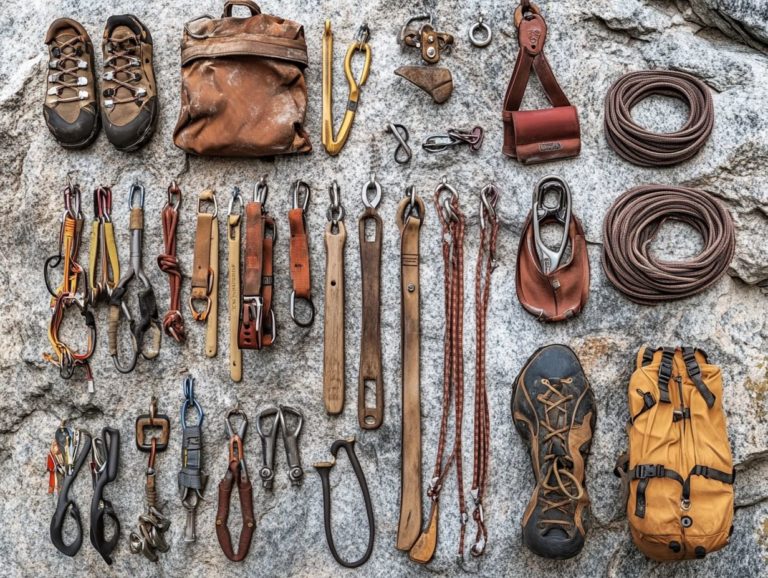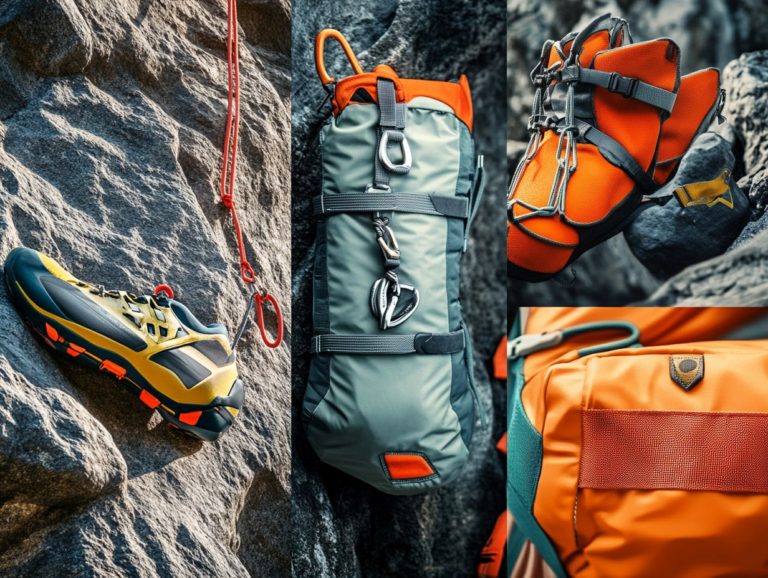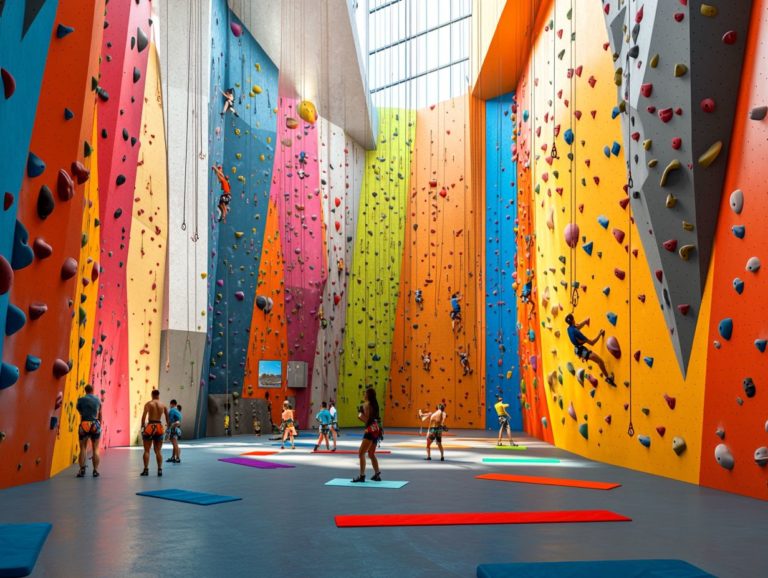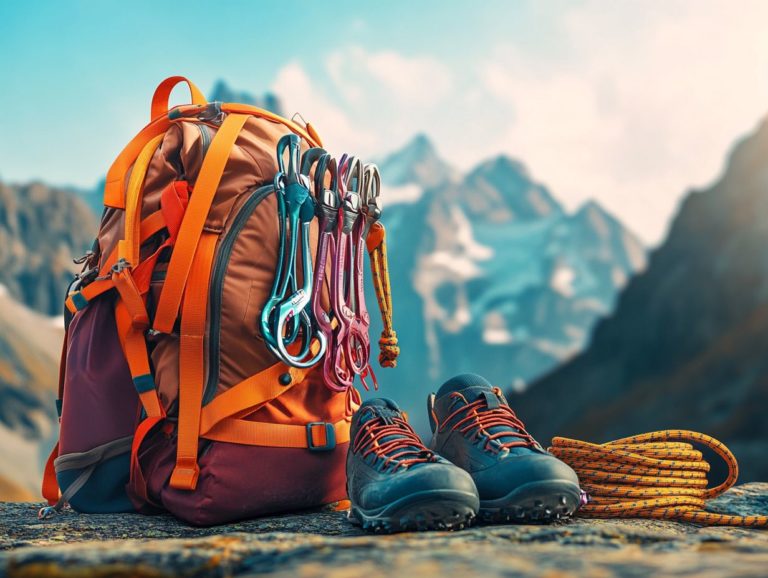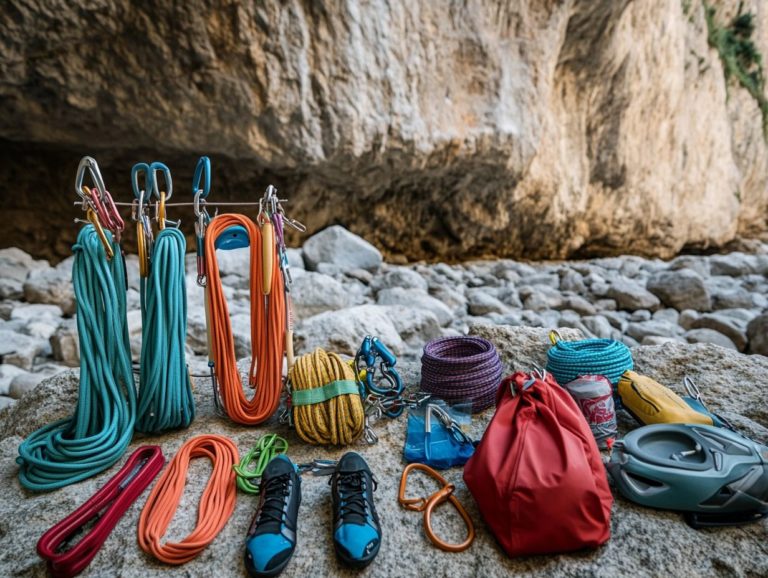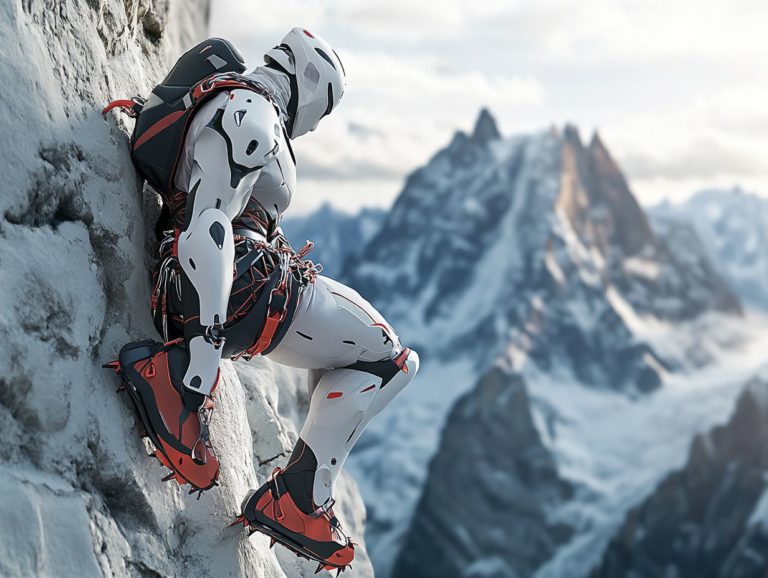How to Maintain Your Climbing Gear
Climbing is an exhilarating sport that requires skill, strength, and the right gear. Understanding essential equipment and how to use it properly is vital to ensuring a safe and enjoyable experience.
Get ready to discover the gear that will elevate your climbing adventure! This guide will walk you through the types of climbing gear you’ll need and how to care for it. You’ll learn effective cleaning techniques, optimal storage tips, and when it’s time to replace your gear. Regular safety checks are also crucial.
Whether you re a seasoned climber or just beginning your journey, this guide will empower you to keep your gear in top shape for every ascent.
Contents
Key Takeaways:
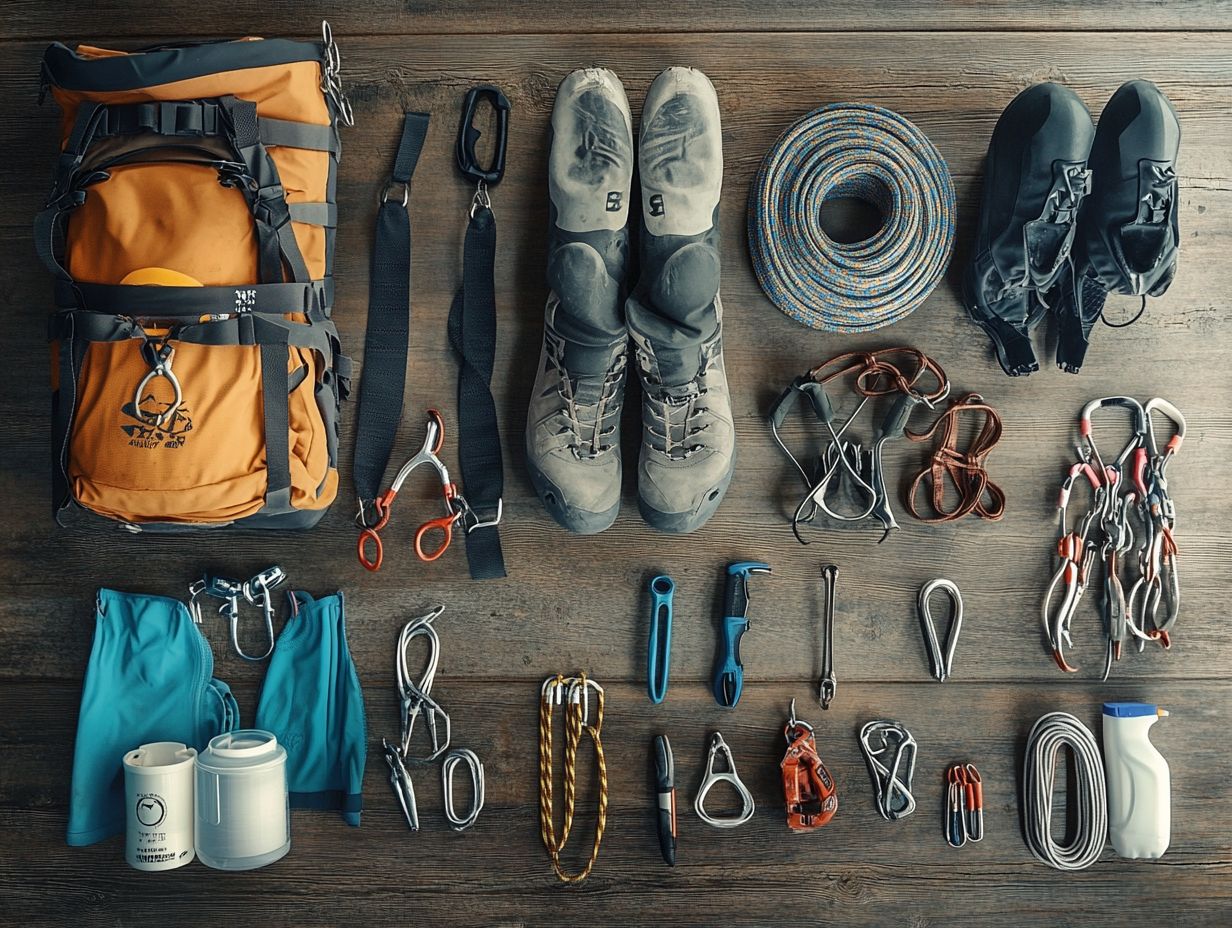
- Proactively cleaning and maintaining your climbing gear is crucial for safety and longevity.
- Regularly check and replace worn or damaged gear, and upgrade with newer technology for improved performance.
- Proper storage and careful inspections will help ensure the safety of your gear and prevent accidents while climbing.
Why is it Important?
Understanding how to maintain your climbing gear is crucial for your safety and performance during climbs. Periodic inspection and proper care of your equipment like carabiners, belay devices, and climbing harnesses ensure they remain in great condition.
Don’t risk your safety! Regular maintenance is essential to prevent gear failure, which heightens the risks during climbs and can jeopardize lives. Understanding the role of gear in climbing safety and engaging with the climbing community can enhance your overall climbing experience and extend the life of your gear.
The risks of neglecting maintenance are serious; worn ropes can snap under pressure, and corroded carabiners might not hold your weight, leading to dangerous situations. That’s why understanding the importance of climbing gear inspection is crucial. Regularly cleaning and checking your hardware boosts performance and ensures safety, allowing you to ascend with confidence.
By incorporating effective maintenance techniques like thorough inspections and proper storage, you can trust your gear completely, letting you focus on your technique during climbs. To learn more about these practices, check out this guide on how to maintain your hiking gear. Caring for your gear fosters safety and transforms your climbing journey into a more enjoyable and confident experience, making each adventure memorable.
Essential Gear for Climbing
Essential gear for climbing includes a comprehensive array of equipment that guarantees safety, enhances performance, and ensures the success of your climbing endeavors.
Key components such as climbing harnesses, ropes, carabiners, belay devices, climbing aids, and pulleys each fulfill specific roles critical to your safety and effectiveness on the rock.
Recognizing the purpose of each item is vital when selecting the right gear tailored to different climbing conditions and your personal techniques. This understanding is key to maintaining both safety and optimal performance as you tackle each ascent.
Types of Gear and Their Uses
In the world of climbing, each type of gear serves a specific purpose, significantly enhancing your experience and safety on the rock. Equipment like belay devices, climbing aids, and pulleys are critical components in various climbing methods and techniques.
For instance, belay devices help you control the rope, while climbing aids assist in upward movement, showcasing the diverse functionalities tailored to meet your needs. Understanding these distinctions is vital for choosing gear that aligns perfectly with your climbing adventures.
Harnesses are your lifeline, providing crucial support and security to ensure you re safely connected to the rope. Likewise, carabiners and slings offer the versatility and reliability needed for securing climbing lines or gear.
The choice of climbing shoes also plays a significant role in your performance; specialized footwear helps maintain grip on various surfaces, enhancing your mobility and balance. By selecting the right gear, you not only improve your effectiveness but also significantly reduce the risks associated with the sport, ultimately making every ascent safer and more enjoyable.
This knowledge enables you to make informed decisions, allowing you to focus on the thrill of conquering new heights.
Cleaning and Care for Climbing Gear
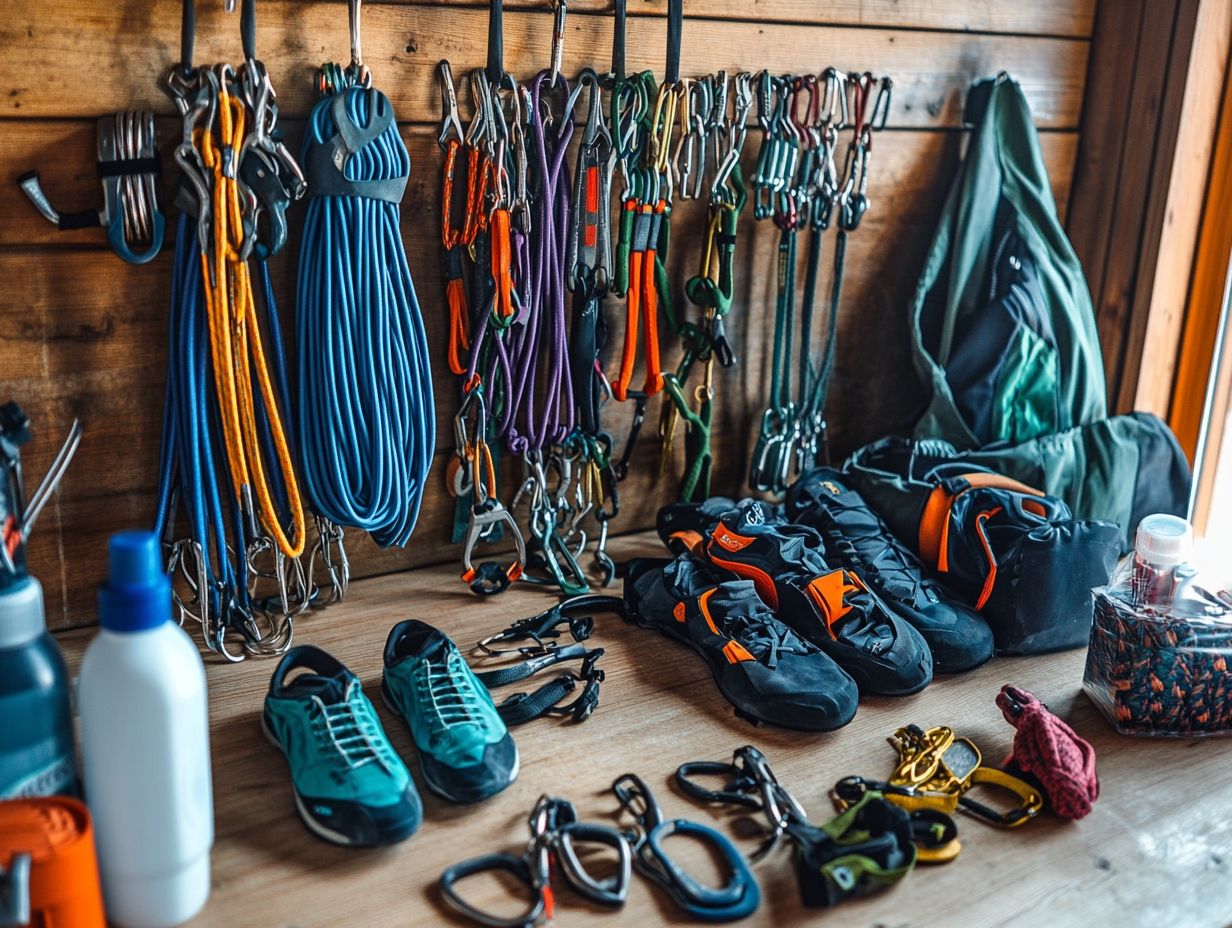
Keep your gear in top shape for every climb! Caring for your climbing gear is an important routine that guarantees the longevity and reliability of your equipment. Regularly removing dirt and cleaning ascenders is vital for maintaining the performance of your climbing hardware, such as carabiners and belay devices.
Lubrication techniques significantly enhance your gear’s functionality. Following proper cleaning and care steps reduces the risks of equipment failure and elevates your overall climbing experience. For those looking to improve their setup, check out the top climbing gear for rock climbers.
Proper Cleaning Techniques
Proper cleaning techniques are essential for your climbing gear. They help prevent the buildup of dirt that could compromise your safety. By using effective cleaning solutions designed for climbing equipment, you ensure that your carabiners, ropes, and harnesses remain in optimal condition.
Regular inspections are crucial. They allow you to spot and address potential issues before they escalate. Integrating these practices into your maintenance routine enhances the longevity and performance of your gear.
For instance, soak your ropes in a mild detergent mixed with warm water to remove grime without damaging the fibers. Give your carabiners a gentle scrub with a soft-bristled brush to clear out dust or debris.
Pick the right cleaning solution. Avoid bleach and harsh chemicals that may damage your gear. Your periodic inspections should include checking for frays, corrosion, or any unusual wear patterns, which could indicate the need for repairs or replacements.
Understanding the link between diligent cleaning practices and climbing safety enables you to take proactive steps. This ensures your adventures are both secure and enjoyable.
Storage and Maintenance Tips
Effective storage and maintenance tips are essential for preserving the integrity and safety of your climbing gear. Proper gear storage protects your equipment from environmental factors and ensures easy access.
Implement best practices for maintenance. Keep your climbing ropes untangled and store metal components in a dry area. This not only enhances the longevity of your gear but also bolsters your safety on the wall.
Organize your climbing gear into compartments for quick access. This makes climbing preparation a breeze. Using breathable bags for your ropes and harnesses helps prevent moisture buildup, while reflective labels on your bins save valuable time during gear checks.
Regularly inspect your equipment for signs of wear and tear. Any fraying or rust should signal an immediate replacement. When storing your climbing shoes, keep them in a cool area to prevent degradation of the materials.
These thoughtful practices extend the lifespan of your gear and significantly contribute to safer climbing experiences.
Replacing and Upgrading Gear
Replacing and upgrading climbing gear is a vital aspect of climbing maintenance that safeguards your safety and enhances your performance during exhilarating ascents. It’s crucial to recognize when it s time to replace essentials like ropes and harnesses to prevent potential failures that could result in accidents.
Keep an eye out for signs of wear, such as micro-cracks or frayed materials. These are clear indicators that it s time for an upgrade. By staying informed about the latest advancements in climbing technology and techniques, you can make well-informed choices that elevate your gear to the next level.
Take these steps now to ensure your climbing adventures are safe and enjoyable!
When to Replace and How to Choose Upgrades
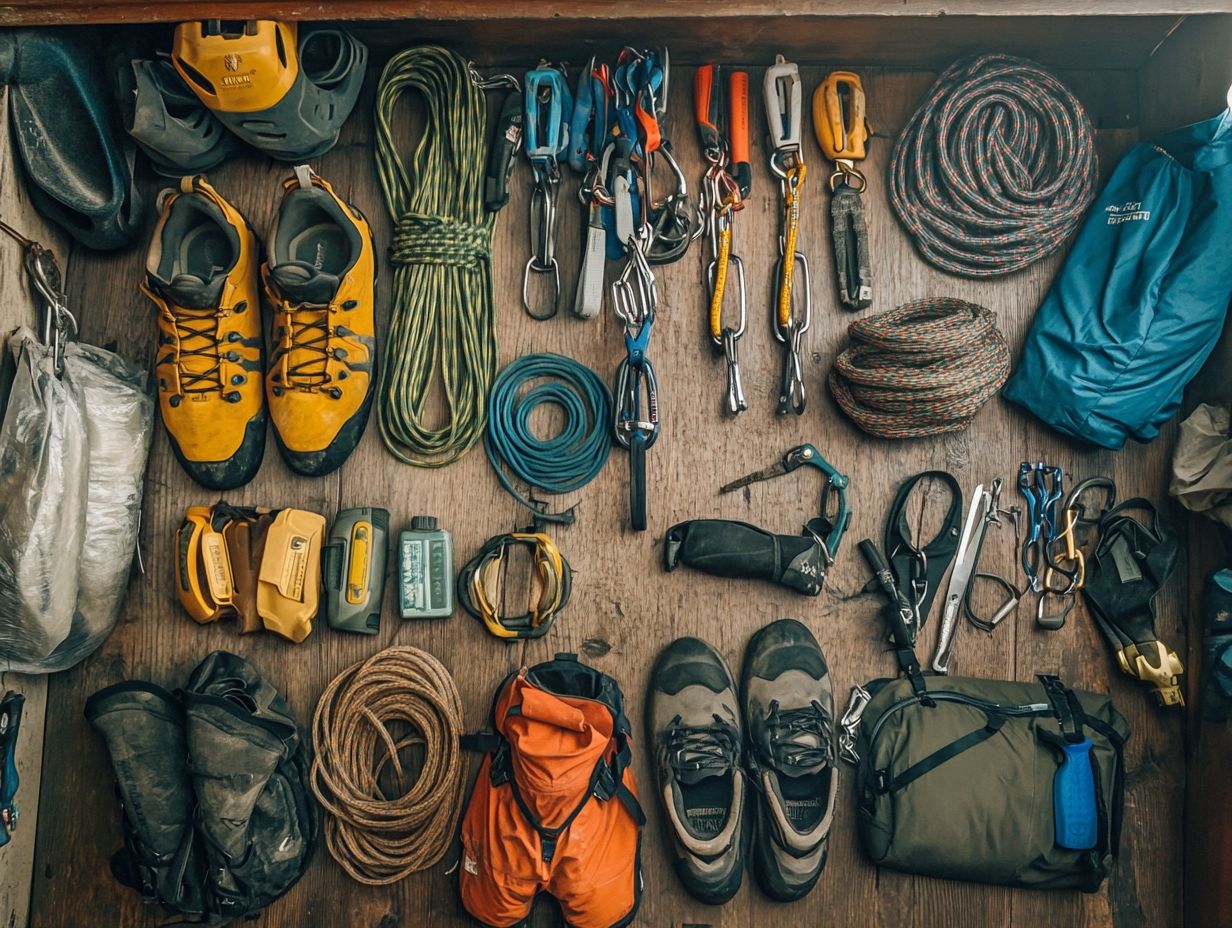
Knowing when to replace your climbing gear is all about regular inspections. This practice allows you to assess the condition of your equipment and reduce climbing risks. If you spot signs of wear, like frayed ropes or damaged carabiners, it s time to consider a replacement.
Upgrading your gear means staying informed about advancements in climbing technology that can significantly enhance both your performance and safety. Making informed decisions about replacements and upgrades not only protects you but also elevates your climbing experiences with top-notch equipment. For more information, check out our guide on understanding the different types of climbing gear.
During your inspections, keep an eye out for indicators of wear look for cuts, burns, or any unusual stiffness in your ropes, as well as signs of corrosion on metal components like belay devices and quickdraws. Attention to detail is crucial; even the tiniest imperfection could compromise your safety.
When considering upgrades, research new materials and technologies that promise durability and improved usability. Tailoring your gear choices to match your climbing style, whether trad (traditional), sport (bolted routes), or alpine (mountain climbing), ensures you harness the latest advancements to boost your performance and confidence on the rock face. Additionally, knowing how to repair common climbing gear issues can further enhance your climbing experience.
Safety Checks and Inspections
Perform thorough safety checks and inspections to keep your climbing adventures safe and fun! Establish regular inspection methods like checking for dirt accumulation, corrosion on metal components, and the functionality of climbing hardware to prioritize your safety.
Within the climbing community, there’s a strong emphasis on sharing knowledge and techniques related to these inspections, fostering a culture of safety. Learning how to properly clean your climbing gear is essential. By prioritizing these checks, you significantly reduce risks and elevate your overall climbing experience.
How to Ensure Gear is Safe to Use
To ensure your climbing gear is safe for use, conduct thorough inspections, focusing on critical details such as identifying tiny cracks and evaluating the overall condition of your equipment. Regularly checking carabiners, belay devices, and climbing ropes is not just a good practice; it s your safeguard against accidents and a key factor in enhancing your climbing safety.
By embracing effective climbing safety tips and implementing a diligent inspection routine, you boost your performance and confidence during every adventure. Additionally, following top tips for caring for your climbing gear will enhance your safety. This proactive mindset contributes to a culture of safety within the climbing community.
Start with a visual inspection, examining each piece of gear for any visible signs of damage. Focus on areas that are prone to wear, like the spine of carabiners and the loop of harnesses. Next, engage in a tactile inspection; feeling for irregularities can uncover tiny cracks or abnormal wear patterns that might not be immediately obvious. It’s also important to keep track of your gear’s age; older equipment, even if it looks fine, may not function as reliably as you’d hope. For more tips on maintaining your gear, check out this guide on how to organize your climbing gear.
Incorporating this rigorous approach not only enhances your safety but also promotes greater efficiency in your climbing techniques, ensuring that each ascent is both enjoyable and secure. To maximize your prep, learn how to pack your climbing gear efficiently and don’t wait until your next climb—check your gear today!
Frequently Asked Questions
This section addresses some common queries regarding climbing gear maintenance and safety.
How do I properly clean my climbing gear?
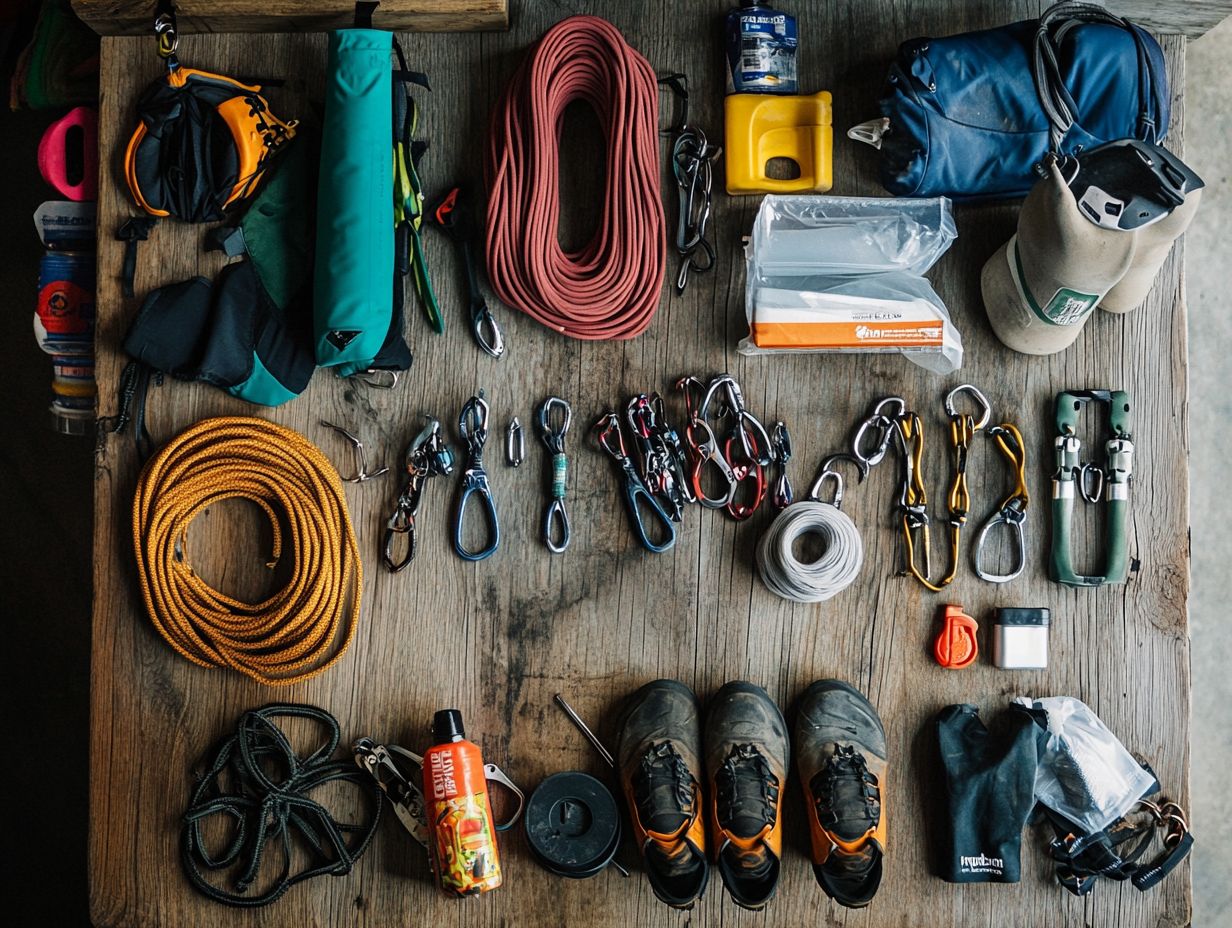
To clean your climbing gear, start by inspecting each piece for any dirt, debris, or damage. Use a mild soap and water solution to gently scrub away any dirt or grime. Rinse thoroughly and hang to dry in a well-ventilated area. Avoid harsh chemicals or bleach, as this can damage the materials. Always follow the manufacturer’s cleaning instructions for specific gear.
How often should I replace my climbing gear?
Regularly inspect and replace your climbing gear when necessary. This will depend on how often you use it and its overall condition. Typically, ropes and harnesses should be replaced every 5 years, while carabiners, cams, and other hardware should be replaced every 10 years. If you notice any damage or wear and tear, replace the gear immediately.
What is the best way to store my climbing gear?
When not in use, it is crucial to properly store your climbing gear to maintain its longevity. Keep ropes and harnesses in a cool, dry place away from direct sunlight.
Hang them up to prevent knots or tangles. Carabiners and other hardware can be stored in a container or bag to protect them from dust and moisture.
How can I prevent my climbing gear from getting damaged?
One of the best ways to prevent damage to your climbing gear is to use and maintain it properly. Always follow the manufacturer’s instructions and never overload or misuse your gear.
After each use, check your gear for any damage. If any pieces are damaged or worn, replace them immediately to prevent accidents.
Can I repair my climbing gear?
In some cases, minor repairs can be made to climbing gear. However, some gear, like ropes and harnesses, can t be mended because they must meet strict safety standards.
If you are unsure whether your gear can be repaired, consult a professional or contact the manufacturer for guidance.
Should I get my climbing gear professionally inspected?
Yes! It is recommended to have your climbing gear professionally inspected at least once a year. This is especially important for gear used frequently or in harsh conditions.
A professional can spot potential issues or damage that may not be visible to the untrained eye. Don t wait! Schedule your gear inspection today to ensure your climbing safety!

